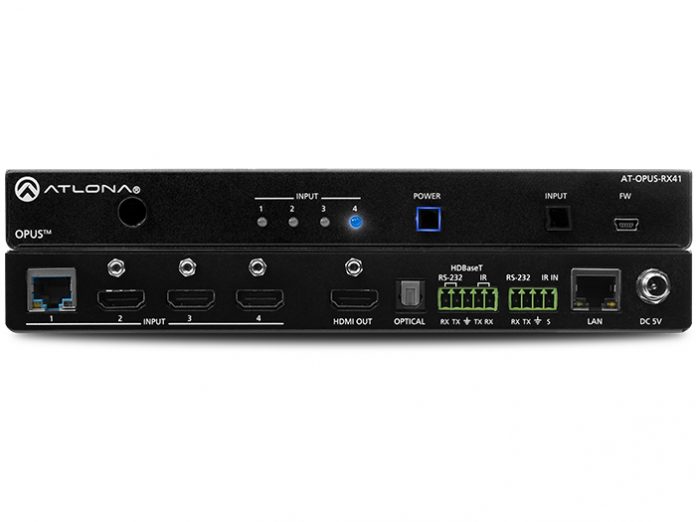Atlona announces the immediate availability of AT-OPUS-RX41, a 4×1 HDMI and HDBaseT switcher/receiver and member of the Opus Series of 4K HDR signal distribution and extension products. The OPUS-RX41 offers three HDMI inputs for local devices, plus one HDBaseT input to receive video, embedded audio,Ethernet pass-through, power, and bidirectional control signals over distances up to 330 feet (100 meters).
Supporting 4K/UHD @ 60 Hz with 4:4:4 chroma sampling, and high dynamic range formats such as HDR10, HLG, and Dolby Vision, the OPUS-RX41 is the perfect complement to Opus Series matrix switchers, including the AT-OPUS-46M (4×6); AT-OPUS-68M (6×8); and AT-OPUS-810M (8×10). It ideal for displaying 4K/UHD HDR content from either a centralized matrix switcher or one of the connected local sources.
“The Opus Series has changed the game for a wide range of small-to-medium-sized residential and light commercial applications requiring flexible, multi-zone AV distribution that is futureproofed for emerging formats and resolutions,” said David Shamir, VP of Product Management, Atlona. “The OPUS-RX41 expands the line with a full complement of local switching, audio return, control extension, and unique integration capabilities.
The OPUS-RX41 includes an number of key features that enhance functionality as well as help simplify residential and light commercial deployments. Extension of CEC as well as bidirectional IR and RS-232 signals over HDBaseT allows a control system connected to the OPUS-RX41 to select inputs on the matrix or control its sources, and allows the matrix to control the local room display.
Advanced HDMI Audio Return Channel (ARC) routes audio from a smart TV to TOSLINK for local audio playback as well as through HDBaseT to an OPUS matrix switcher for whole house audio distribution. EDID management, selectable 4K to 1080p downscaling, and HDCP 2.2 support with selectable down-conversion to HDCP 1.4 ensure compatibility with legacy HD displays. Remote power allows the device to be powered by an Opus matrix switcher, for convenient installation at a display or projector without a local power supply.





